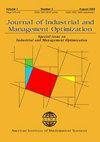Impact of deferred payment on decisions and coordination in a dual-channel supply Chain with a risk-averse retailer
IF 1.6
4区 工程技术
Q3 ENGINEERING, MULTIDISCIPLINARY
引用次数: 0
Abstract
As the Internet rapidly grows, manufacturers tend to open a direct channel to distribute the products in addition to traditional channels. Meantime, retailers may have difficulty in making immediate payments due to limited capital. Confronting with the channel encroachment, financial pressure, and uncertain demand, retailers may also show a risk averse attitude, which was rarely considered in literature. This study considers a dual-channel supply chain wherein a retailer may be capital constrained and is risk averse. Two scenarios are respectively modeled as a Stackelberg game. One is that the retailer has adequate capital, the other is that the retailer is capital constrained and a manufacturer prefers to provide a deferred payment contract. The results show that the manufacturer present a high degree of willingness to offer the delayed payment to an extremely risk-averse retailer. Further, when such a payment contract is offered, the manufacturer's or even the entire supply chain's profits may decrease. Moreover, a deferred payment contract may benefit the entire supply chain only if the unit production cost is relatively large. Finally, a mixed contract that combines revenue sharing and deferred payment is introduced to achieve the coordination of the dual-channel supply chain.风险规避型零售商双渠道供应链中延迟支付对决策和协调的影响
随着互联网的快速发展,在传统渠道之外,制造商倾向于开辟一个直接的渠道来分销产品。与此同时,由于资金有限,零售商可能难以立即付款。面对渠道侵占、资金压力和不确定的需求,零售商也可能表现出规避风险的态度,这在文献中很少被考虑。本研究考虑了一个双渠道供应链,其中零售商可能是资本约束和风险厌恶。将两种情况分别建模为Stackelberg博弈。一是零售商有充足的资金,二是零售商资金受限,制造商更愿意提供延期付款合同。结果表明,制造商对一个极度厌恶风险的零售商表现出高度的延迟付款意愿。此外,当提供这样的支付合同时,制造商甚至整个供应链的利润可能会减少。而且,延迟付款合同只有在单位生产成本比较大的情况下才可能使整个供应链受益。最后,引入收益共享与延期支付相结合的混合契约,实现双渠道供应链的协调。
本文章由计算机程序翻译,如有差异,请以英文原文为准。
求助全文
约1分钟内获得全文
求助全文
来源期刊
CiteScore
2.50
自引率
15.40%
发文量
207
审稿时长
18 months
期刊介绍:
JIMO is an international journal devoted to publishing peer-reviewed, high quality, original papers on the non-trivial interplay between numerical optimization methods and practically significant problems in industry or management so as to achieve superior design, planning and/or operation. Its objective is to promote collaboration between optimization specialists, industrial practitioners and management scientists so that important practical industrial and management problems can be addressed by the use of appropriate, recent advanced optimization techniques.

 求助内容:
求助内容: 应助结果提醒方式:
应助结果提醒方式:


